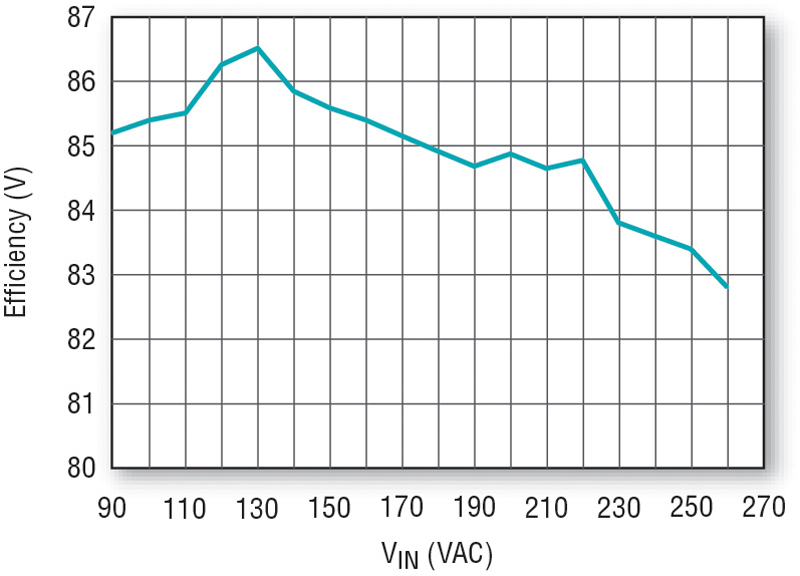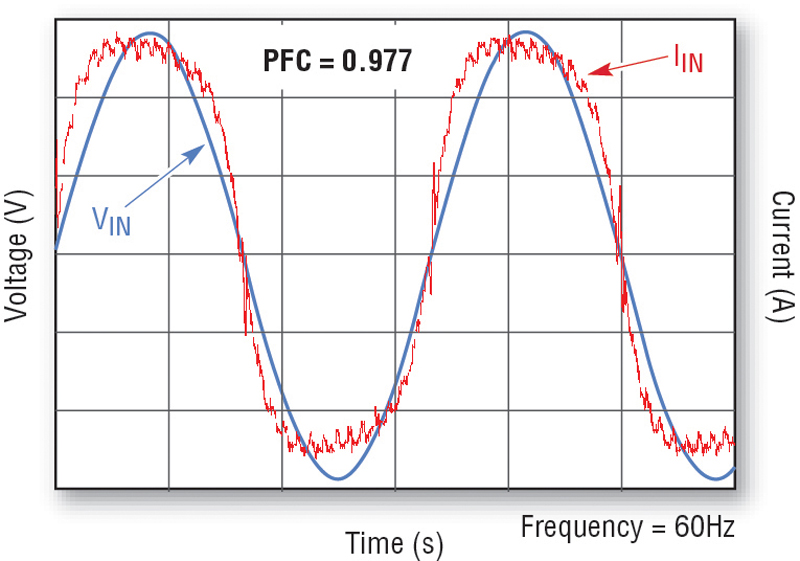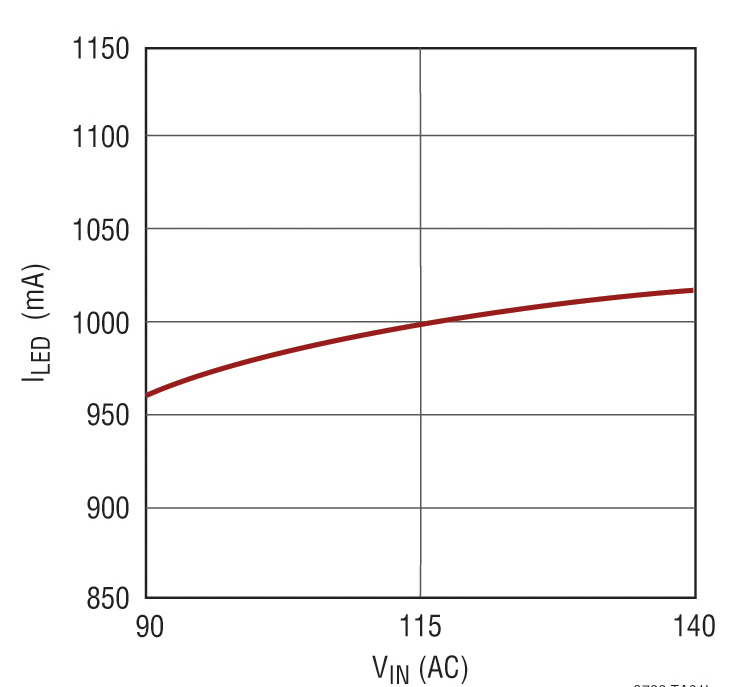Author:
Jeff Gruetter, Sr. Product Marketing Engineer, Power Products, Linear Technology
Date
06/11/2011
Most of the new LED lighting fixture applications will be required to run from existing AC offline power sources, generally 90VAC to 265VAC depending on the end application's geography. The ability to drive LEDs effectively from AC offline power presents some rather unique LED IC driver design challenges. Background As the power savings capability, long life and additional benefits of high brightness LEDs continue to drive the development of a wide range of lighting applications, it is no surprise that the growth rate of LEDs continues to accelerate. By the end of 2010, the market size for high brightness LEDs reached $8.2 billion and will grow to $20.2 billion by 2015 at a 30.6% CAGR ramp according to Strategies Unlimited. In the past few years, LEDs used to backlight displays have been the major driver of growth. However, as general lighting LED applications gain traction in both commercial and residential markets, they are further accelerating growth. Global market intelligence supplier LEDinside reports, "In 2010, phenomenal growth was seen in the high lumen LED lighting systems for commercial use. This is because the LED lighting for household use is still too expensive for most consumers. Backed by its long-term benefits, energy-saving and environment-friendly attributes, and its relevant tax reductions, there will be a substantial increase in the use of LED lighting in commercial spaces such as the parking lot, office space, factories and warehouses. LED lights can replace not only high pressure sodium lamps, halogen lights, incandescent bulbs, but also CFL and fluorescent lights in some areas." LEDinside further estimates, "Rapid growth and widespread adoption of LED commercial lighting will take place in 2010 and 2011, while LEDs used for household lighting will not take off until 2011 or 2012, the key year being 2012. The market penetration rate of LED light source was expected to reach 3.7% in 2010 and the compound annual growth rate between 2009 and 2013 is estimated at 32%." It should come as no surprise that commercial applications are leading the transition to LEDs as lighting generally represents from 25% to 40% of total energy use in commercial buildings. As these applications require long hours of high intensity light, the economic payback of the saved electrical power is relatively short term. Secondly, the long life of LED fixtures dramatically reduces the replacement cost of the bulbs. These replacement costs not only include the price of the bulb itself, but also the labor cost to physically replace them, which in certain applications such as high bay lighting, are significant. Conversely, at this time, general purpose LED lighting for household-use is still too expensive for most consumers. However, in the coming years as LED fixture prices decline and become more widely available, the residential sector of the lighting market will also grow substantially. Most analysts expect this segment of the market to grow moderately in 2011, accelerating in 2012 and beyond. As previously mentioned, the primary driver behind the high growth rate of LED lighting is the dramatic reduction in power consumption that LED lighting offers over traditional lighting. Compared to incandescent lighting, LEDs require less than 20% of the electrical power to provide the same level of light (in lumens). As can be seen in Table 1, there are additional advantages that LED lighting offers, but also some additional challenges. LED advantages include a lifetime orders of magnitude higher than incandescent lights, which dramatically reduces replacement costs. The ability to dim LEDs using the previously installed base of TRIAC dimmers is also a major benefit, especially in residential lighting. Instant turn-on eliminates the warm-up period associated with CFLs and LEDs are not sensitive to power cycling like their CFL counterparts. Additionally, LED lighting fixtures do not contain any toxic materials to manage or dispose of, whereas CFL utilizes toxic mercury gas to operate. Lastly, LEDs enable new very low profile form factors that other technologies could not. The breadth of these new LED lighting applications is very wide, ranging from 4W screw-in incandescent replacement bulbs to 100W street lamps to commercial high bay fixtures, requiring hundreds of Watts. Most of these LED lighting fixtures will be required to run from existing AC offline power sources, generally 90VAC to 265VAC depending on the end application's geography. The ability to drive LEDs effectively from AC offline power presents some rather unique LED IC driver design challenges. Not only must the LED drivers offer maximum efficiency to ensure power savings but they must also offer electrical isolation for safety concerns. Additionally, they must offer Power Factor Correction (PFC) and low harmonic distortion to be practical in a broad range of applications. Furthermore, in many residential applications they must offer dimming capability with existing TRIAC dimmers. Finally, the total solution footprint needs to be very compact to fit into a replacement fixture and also be cost effective to entice both commercial and residential users into changing over. Having LED driver ICs available that can meet all of these requirements is paramount to the continuing adoption of LED lighting. LED Lighting Math One of the major driving forces behind the rapid growth of LED lighting is the dramatic power savings they can offer over incandescent or even CFL lighting. Therefore, it makes sense to review the power savings that can be realized with existing LEDs and how this will improve over the next few years. A 60W incandescent bulb: Delivers approximately 800 lumens, which translates into 13.3 lumens/watt (lms/W) Existing LEDs: Current efficacy ranges from 50 lms/W to 170 lms/W for commercially available product. Future LEDs: Efficacy ranges from 200 lms/W to 230 lms/W will be available. Nevertheless, the maximum theoretical efficacy is ~250 lms/W. For illustration purposes, let's consider LEDs with 100 lms/W. Therefore, the electrical power required for the LED itself will be 800 lumens/100 lms/W = 8W. However, the efficiency of the AC/DC LED drive electronics must also be taken into account, which is 85% for a high performance LED driver. Thus, the total required offline power would be 8W/0.85 = 9.4W, resulting in a power savings of 84% compared to an incandescent. If a more conservative figure of 65 lms/W is used, a net savings of 75% of the power used relative to an incandescent bulb is realized. Looking to the future when LEDs delivering 200 lms/W are available, the power saving jumps to 92%. In order to meet the current energy star requirements, LED replacement bulbs must deliver at least 75% power savings relative to standard incandescent bulbs. Powering LEDS from Offline Power The ability to drive LEDs from an offline power source enables applications to grow exponentially as this form of electrical power is readily available in both commercial and residential dwellings. Although LED replacement fixtures are relatively simple for the end user to implement, the new requirements placed on the LED driver IC go up dramatically. As LEDs require a well regulated constant current source to deliver a constant level of light output, powering them from an AC input source requires some special design techniques with very specific design needs. Depending on where in the world you are, the offline power will range somewhere between 90VAC and 265VAC with a frequency between 50Hz and 65Hz. Therefore, manufacturing a LED fixture for the worldwide market would ideally have a single circuit design that could enable it to be used anywhere in the world without modifications. This requires a single LED driver IC that can handle a wide range of input voltages and line frequencies. Furthermore, many offline LED applications require electrical isolation of the LEDs from the drive circuit. This is primarily driven by safety factors and is required by several regulatory agencies. Electrical isolation is generally provided by an isolated flyback LED driver topology that utilizes a transformer separating the primary and secondary sections of the drive circuit. As the driving force behind LED lighting's adoption is the dramatic reduction of power required to deliver a specific quantity of light, it is imperative that the LED driver IC delivers the highest level of efficiency. Because the LED driver circuit must convert high voltage AC power to well regulated LED current at a lower voltage, the LED driver IC must be designed to deliver efficiencies above 80% so as not to waste power. Moreover, in order for LED retrofit lamps to be feasible with the large base of installed TRIAC dimmers commonly found in residential applications, the LED driver IC must operate effectively with these dimmers. TRIAC dimmers are designed to work well with incandescent and halogen lamps, which are perfect resistive loads. However, the LED driver circuit is generally nonlinear and is not a purely resistive load. Its input bridge rectifier typically draws high intensity peaks of current when the AC input voltage is at its positive and negative peaks. Therefore, the LED driver IC must be designed to "mimic" a purely resistive load to ensure that the LED starts properly without exhibiting any visible flicker and dims properly with a TRIAC. PFC is an important specification for LED lighting. Simply put, a power correction factor of one is achieved if the current drawn is proportional and in-phase with the input voltage. Because an incandescent lamp is a perfectly resistive load, the input current and the voltage are in-phase and the PFC is 1. PFC is particularly important as it relates to the amount of electrical power required by the local power supplier. Namely, in an electric power system, a load with a low power factor draws more current than a load with a high power factor for the same amount of useful power transferred. The higher required currents increase the energy lost in the distribution system, which in turn requires require larger wires and other transmission equipment. Because of the costs of larger equipment and wasted energy, electric utility companies will usually charge a higher cost to industrial or commercial customers where there is a low power factor. International standards are still developing for LED applications, but most believe that a PFC>0.90 will be required for LED lighting applications. Because a LED driver circuit (which includes an array of diodes, transformers and capacitors) does not act like a purely resistive load, it can have a PFC as low as 0.5. In order to raise the PFC above 0.9, either an active or passive PFC circuit must be designed into the LED driver circuit. It should also be noted that high PFC is particularly important in application that uses over several hundred 50W LED fixtures, a high PFC (>0.95) LED driver design will be beneficial. In addition to a high PFC, it is also important to minimize the harmonic distortion levels in LED fixtures. The International Electrotechnical Commission has developed an IEC 61000-3-2, Class C Lighting Equipment Harmonics specification to ensure that new LED lighting fixtures meet these low distortion requirements. Accurate LED current regulation over a wide variation of line voltage, output voltage and temperature is critical in lighting applications as variations in LED brightness must be imperceptible by the human eye. Similarly, to ensure the longest operation life of the LEDs, it is important not to drive them with current above their maximum ratings. LED current regulation in isolated flyback applications is not always straight forward and often requires an opto-coupler to complete the required feedback loop, or an additional conversion stage can be added. However, both of these methods add complexity and reliability concerns. Fortunately, some LED IC driver designs incorporate new design techniques that provide accurate LED current regulation without these additional components or design complexity. Finally, the largest obstacle to instant transition from incandescent bulbs to LED replacements is the cost and size of the LED based solutions. Consumers are used to paying less than $1.00 for a replacement 60W incandescent bulb and approximately $3.00 for a CFL equivalent. Paying over $30 for a LED replacement is a large hurdle for consumers to overcome. At these prices, the reduced electricity and replacement costs over the lifetime of the LED, does make economic sense but consumers aren't used to making this connection. In general, commercial businesses that have a significant energy bill specifically for lighting, such as warehouses and parking garages, are much quicker to adopt LED lighting as the cost savings are more obvious. As the purchase cost of LED replacement solutions comes down, more consumers will be willing to make the transition to LED lighting. An equally important factor is the size of the LED lighting solution. Many are direct screw-in replacements, thus the entire solution must fit in the same shape and volume of the original incandescent bulb. As LEDs require a heat sink and a much more complicated driver circuit, fitting both of these in the same volume footprint can be a challenge. Therefore, LED driver ICs that can offer all of these required features in a simple and compact solution footprint will be needed.

A Brand New Solution Fortunately, there is a new solution to all of these offline LED driving challenges, Linear Technology's LT3799. It is an isolated flyback LED controller with active PFC, specifically designed for driving LEDs from a universal input range of 90VAC to 265VAC. The LT3799 uses a critical conduction mode, minimizing the size of the external transformer. It is ideal for driving a wide range of LED applications ranging from 4W of LED power to hundreds of Watts. The entire circuit to drive up to 20W of LED current can is shown in figure 2. This particular circuit is TRIAC dimmable and can deliver up to 1A of LED current from a universal input range of 90VAC to 265VAC, while delivering efficiencies of over 86% (see Figure 3). With a few changes in externals, this circuit can be optimized further for 120VAC, 240VAC or even 377VAC applications or virtually any commonly found AC input. The LT3799 utilizes a single stage design with the entire LED drive circuit (including the EMI filter) requiring only 40 external components, keeping the solution footprint simple, compact and cost effective. The overall dimensions of the 20W circuit in Figure 2 is only 30mm x 75mm with a profile of only 30mm, making it ideal for a wide variety of LED applications.


The LT3799 utilizes unique internal circuitry that provides active PFC of up to 0.98; easily meeting industrial U.S. Department of Energy (DOE) requirements while also complying with the IEC 61000-3-2 Class C Lighting Equipment Harmonics requirement (see Figure 4).

Additionally, the LT3799 offers LED current regulation over input voltage, output voltage and temperature. Looking at Figure 5, one can see that the LED current remains within +5% regulation when the input varies from 90VAC to 150VAC as would be required in most US lighting applications. In lieu of an opto-coupler, the LT3799 has a unique current sensing scheme to deliver a well regulated current to the secondary side. This not only reduces cost, but also improves reliability. The LT3799 can also be used with a standard in-wall TRIAC dimmer without any visible flicker. Integrated open and shorted LED protection ensures long-term reliability for a wide range of LED applications. Finally, its thermally enhanced MSOP-16 package offers a very compact LED driver solution. Conclusion The unprecedented acceleration of LED general lighting applications powered by offline sources is driven by a continual demand for higher performance and cost effectiveness. However, these emerging performance requirements must be enabled by new LED driver ICs. These LED drivers must provide electrical isolation, high efficiency, PFC and TRIAC dimming capability. Additionally, they must deliver well regulated LED current in order to maintain uniform brightness, regardless of input voltage or LED forward voltage variations while offering a variety of protection features to enhance system reliability. These LED driver circuits must also enable a very compact and cost-effective solution. Fortunately, this type of offline LED driver now exists. www.linear.com